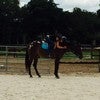Description
About This Video
Transcript
Read Full Transcript
I'm Debra Colet and I'm here with my friend Kaitlin and I'm going to show a series of exercises that I think are interesting, a to show the importance of the sideline of our body in exercises where you think it's obvious and then exercises where that support is really, really important but maybe less obvious. And we're going to start using the ladder barrel as our first helper. So Katelyn, go ahead and pray. In this instance, you're going to take your right leg, which is going to be your forward leg, place it in front, and then take the left leg behind. So barrels are different. This is the ladder barrel. Some of you might have an insert that fits in there nicely.
The bottom line is that we're starting with our feet low, so it's relatively easy. The angle on her body is going to be relatively easy to do and then we want it padded so that doesn't hurt her feet and then lift up and place the, the outer thigh or the greater trocanter right up on what I call the, the beginning of the over curve of the barrel. So how you set your barrel up is important. You want to feel that, um, you're not in such a, the barrel is not so far out that you feel like you're sliding down. You actually want to feel like the barrel comes back up at you and kind of pushes you so that you feel like the barrel is giving you a sense of tone that trains that line of tone in your own body all the way from your hip down into your ankle. So she probably has more weight on her left leg than her right leg and that's okay. Okay. Imagine you are sideline doing sidekicks.
We'll show those later. The forward leg in this case is going to be the free leg and the underneath leg is what you might call the support leg and the barrel in this case is acting like a partner of sorts. Right? Coming up and giving you that idea, you still don't want to hang on your partner but you want to feel like you could use that support to try and start to tone that. Okay, so now we're just going to do what you might call side setups or side overs. So Katelyn, go ahead and interlace your fingers all the way into your ponytail and then create [inaudible] even a strength connection here. As you gently press your hands into your skull and your skull into your hands, you're creating a t, a connection of tone all the way through the arm into the shoulder girdle, which is going to support the rib cage and your thoracic spine.
And then here we go. We're going to breathe in and take a little side bend knowing the curve of the barrel as their exhale. As you come back up, you picture that in your mind. There's a curve here. What if I said the barrel, you know, came all the way up under your armpit. What's Nice about it is that you can really feel your legs under you and you feel the legs driving up through the pelvis so you have your pelvis and you have the barrel as a support. Another interesting thing I think is that when you come back, obstacle over, one more time, Katelyn, breathe in the muscles that you're contracting to bring yourself up.
Some of them are the same ones that are going to be holding this top leg up so that when you do free leg things, it's connected. So we'll do one more over you go. So is there so much richness here? Right? And then another thing I really love to do right here, which we'll show, I'm going to just say you can't see Caitlin from the back, but one of the important things is to be very three dimensional with your breath. So in other words, I'm going to say something that it's kind of a little bit like jargon, but if you think of the hundred exercise, and we use this term, the hint of hundreds. So it's like just that little connection into your flexors so you don't push through the t 12 area. So you go over and you want to keep the breath coming into the back and not pull backwards through that side. Okay? You really want to keep the pelvis aligned.
So that same little spot right at the base of your sternum. We're going to rotate around so you stay there and now you're going to rotate toward the barrels squaring off. You're squaring your chest to the barrel. Just rotate your chest to the barrel. Beautiful. And then inhale, come back to center. Exhale and return. One more time. Yup. Nicely done. Go along, twist, inhale, come back and exhale. And then you can just put your hands down and rest. So obviously if you wanted to make that a little bit more challenging, you would increase the load by taking your arms up overhead or even holding a pole. Okay, so then the next phase of this might be to take your whole body up higher so that the load of your whole body is going to be farther out.
It makes the whole thing more challenging. So now go ahead and take your front leg, place it up, and then this one is hooked. Okay. Under this top rung, we've got it padded just so that it's not uncomfortable so that you're willing to exert a little pressure there. Again, we're going to try to work to square off the pelvis itself. You don't have to force the need to be up to the ceiling at all. What's more important is the alignment through this underneath foot, ankle, hip driving right up into the pelvis. Here's that barrel.
But she's got a lot more weight of her torso going out in space. So this would be a way to start to practice more of the more difficult things like your side bend on the mat or twist too. Now you can just come right back up again. So we're going to take this alignment, this kind of package of power and bring it on over to the short box on the reformer. So now I want to show how the power of that sideline is really important in short box. Sometimes we don't really think about it as much.
I know that I remember from the first day the cue that I got to get on the short box was, you know, put your feet in the straps, flips your ankles, hand of space behind your pelvis to take your legs and push them down and depart. And it made sense. Write the down to get the hamstrings to have some little bit of extension in this very flexneri position. And then the upper part, okay, that's your sideline. And it's so important to have the tone around the hips for the ease of the all the different spinal movements that you're going to be doing on short box. So we're going to show how that progresses. So go ahead Caitlin and wrap your arms around your ribs.
Pick up the ribs similarly to how you had to pick yourself up sideways, right? Beautiful. When you were going over the barrel. So you start to tilt your pelvis, you inhale, you roll back, keeping the strong flection, pulling your legs apart. You can see the same connection, ankle, outer knee, greater troll canter, and you want that. So you want that tug on the strap the whole time, tilting the pelvis.
The further back you go, the more strong the base of support has to be, right? So as you go further and further back, a lot of us are just focusing, focusing on our abdominals and and our torso. You've got to stay focused on the support all the way from the ground up. One more time. Inhale, exhale all the way. Okay, you want to go into a back bend? So come back one more time. So right about here, flex the ankles deeply and pull out on your legs and then you can just lay back over my thigh. Exhaling everything. Now keep those hips extending. Flex.
Bring your head forward, take a breath and pull back on the hips. Just like when you got on that barrel the first time and he said, do you want to lift the hip up over the side? It's that same support. It's just, it's not as obvious. Okay? So it's going to be the same thing when you take your, when you take your flat back. Nice straight wrists. Here we are going from the the body closer like when we were sideways to taking the load greater. Okay, so again, lifting up, flexing deeply. We're not going to do a lot of this, but just so interesting to see how it progresses. So tilt back as you inhale, keep reaching, reaching, reaching, lifting both sides now. And exhale, pull those legs apart and feel how the power from the side pulling apart, lifting you up. Beautiful.
So you can see as she tilts back that the movement is around that greater troll cantor, the femoral joint. Really beautiful. Okay, that's enough. Now's where it gets really interesting because we start to go side to side. Okay. And I know a lot of people say, well, should I let opposite hip come up? And it's like yes or no. It's not that you let it come up, but let's look at this. So side bending, um, come back, just just that lateral bend of the ribs as if you were over on the rib cage.
So she side bending to the left suddenly shift your hip to the right. Can you feel how that tones you up? And it makes you less likely to collapse. Most of us have a tendency to fall down into the side that we're going to. So now as you side bend to the right, feel that subtle shift to the left and then come back up. So let's really show kind of an exaggerated version.
Go ahead and side bend over to your left. Take your left hand, put it on the side of the box. And as you push down with that arm, you can feel the, the lift of that hip. It's almost like a little kickstand that gets back onto you. So now, yeah, sure. Reach the arm long. Now go ahead and keep the hand down. Reach your top arm long. This is you going over the barrel. Sure. Let your hip come up, but not because you fell, because you've got the power through those sidelines. You can go farther.
You can enjoy getting a larger side bend. Let's go ahead and do one more on the other side. So in with the breath, as you go over, go ahead and put your right hand down. Use the connection of the hand into the shoulder. Girl, you feel you can lift your weight up, right? And then it drives you into a deeper side bend. But it come on back, it drives you into a deeper side bend because you have the power to do it, not just cause you're like, oh, I think I should go farther. Okay. And then that would also be the same for the twist. Okay.
So again, reaching up the pole, let's start twisting to the right. Okay. A lot what happens with people inhale, that's, that's your left, but that's okay. We'll go to the left. Okay. I want to say one more thing too. Do you remember we talked about this a little hint of hundred.
So this is kind of an interesting thing right now. Okay. Because as we start to twist, we're going to get into a, you know, tendency to overwork the back. All right? So we're going to keep that little hint of hundred. So as you twist and start to lean back, this side acts as a kickstand, right? To push you and then exhaling, find that side bending power to come back up. Let's just go to the right now.
It's very interesting to me because many people when they twist and then they think, oh, I need to go further. I need to go more. I don't want you to hurt yourself, but they tend to fall. They tend to crunch down into the side that they're going to, I'm going to have you do one kind of poorly. Go ahead and twist to the left. I'll help you. So a lot of people, they think I want to go farther. What they do is they dip and they crunch out their back and you don't know what to say to them, right? So you left and come back up. So here's that line again.
So let's show that side one more time. Tilt the pelvis a little bit. Lift the hips out in space. That is beautiful. Now you can keep twisting more because you have the power. Exhale, reach out that side arm and come back. And now let's go ahead and show the sides. Now let's do twist off hip. Bring your legs together because it's not that. It's not that hard. Once you actually start to feel right that underneath side picking you up.
I think that this is interesting and important because we get into thinking where we're going. You hold this for me, it's just like in saw, right when you do, when people do the saw, when I desire, you desire it as a sorry. And we're so focused on getting that little finger out to the toe and then we collapse into our hip instead of actually feeling the the other end of things, which is picking you up and taking you. So it's like that. So people go, we twist and we think, well I have to twist further and you know, we kind of don't feel what's happening on the other side. Okay, so now if we wanted to take this, it's nice to be, you know, to be able to progress, right? But it's not so hard to progress when you actually feel those moment to moment supports. It makes a lot more sense. It's not like a suddenly this whole other heart exercise. It's really a progression. Okay. Which side are you going to go to?
You're going to go to the left. All right, so start as you are. So hint of hundred, lift and twist. Okay, so rotate to your, to your left and now put your hand down on the, on the wood. Use the hand just like you did in that little side bend right to pick you up so that you feel like you can get your pelvis stacked. Remember your hint of hundred so that your rib cage can keep leaning out like there was the barrel there and the legs pulling up on the strap. Ankle, knee, hip, right? And then if you can let go your arm, grab that Pole, lift yourself back up. So obviously, you know we stayed out there for a long time, but I wanted you to experience all the parts. Okay?
So there's your twist off hip, which is scary sometimes, but if you just keep progressing and feel all the bits along the way, it's not, it's not so bad. Now I'd like to show the what we call the side sit-ups. Okay. So you're going to turn onto your side and the leg that you're on. Okay, so Caitlyn is on her left side. We want the entire left flank from that greater trow canter all the way down, whatever. It depends on proportions, obviously length of the bones, but that whole outer thigh should be on on the box. You want to rotate on to it so that your hips are stacked. And then don't be shy about really using strap.
Okay? So internally rotate a little bit to square off and then pull up on the strap. Do you feel that tug right up into your hip? That's really, really great. And then depending on your length, sometimes it's just literally the length of your leg, but sometimes it's the strength, relatively speaking, side to side in the hips. You'll notice if you try this, if you have a weaker side, you might feel more comfortable if you bend this underneath leg more because it's going to give you a broader foundation.
And then as you get more strength, you can start to lengthen that leg out a little bit. Okay? It's not like it's better or worse. Just notice that you might feel different on each side. Okay, so you're going to find the place where you're going to hook that up. Okay. In the very beginning, it's fine to go ahead and place the hand down on the headrest, just like before, right? What are you using that arm for? Not to brace or prop, but to pick some of your weight up so that you can find all the fine points that we've already been looking at, right?
So you can have the other hand behind your head. You can have two hands behind your head. What I like to do, and I'm having a day where I need extra help, is I just grab myself right around both hips. Even this one, Caitlin, can you do it? And you're giving yourself that same lift up. It feels good, doesn't it? Because instead of your weight falling, everything's coming with you where you need to go, okay? And then inhaling as you take yourself over, same idea. Everything's the same, right? Hint of hundred. The imagination of having that rounded barrel, keeping the neck in alignment. There you go.
And then one more time rest. Okay. And obviously the way to start to challenge yourself is just hands on hips, hands on head, hands above head, take a pole. So each little bit that you add a load out in space is going to challenge you. Just like climbing up the ladder. Barrel challenged you. Okay? So now we could do more advanced work on the reformer, but I think what I'd like to do is move us onto the mat.
So now here we are on the mat and I'm going to do regular sidekicks, but being informed by everything else Katelyn's already learned. So as she sets herself up to do the sidekicks, again, we're looking for the pelvis to be level and at the top hip rolls forward. So it's on top of the bottom hip. The bottom hip is that support leg again, right? So if she's off center, it's not going to give her the same oomph. Okay. And then here's her, her barrel ribs, right? So again, hand behind the head, we know the position, but really take into account the strength, the connection from the arm all the way through the shoulder girdle into the ribs. And if you think about the power of these legs now coming all the way up through the torso, then she can reach out now. Now, now, now it's gonna make her leg feel lighter. So you take the top leg up, hip height, flex the ankle. Here we have it again, and now you kicked to the front. Once farther point, the toes come around to the back. And again, so that's the exercise, right?
We know sidekicks. Go ahead. Again, flex, flex and come around. Come around considering the power go a little faster. Inhale x Hale. Inhale once a little farther. Exhale back a little farther. Maintaining her hint of hundred.
Maintaining the power of this standing leg, ankle, knee, hip, driving her right up into that pelvis. You see how she can free the top leg up? Suddenly the work of the top leg, right Caitlin is a little bit easier. Now flex the foot, come around to the front. Keep feeling the power of your underneath side, helping to support you into more of a freedom in the leg. There you go. Okay. And then close the legs up. One on top of the other. Take the top leg in front of the bottom leg slightly so that your heels in front of your ankle. Okay. Now you remember when we were on the barrel and that top leg was bent up at the angle. So here it is again. We have to get the turnout, the rotation.
So kick the leg up to the side, flex, pull it down. And again, regardless of how tight you think you are, keep going. And was the breath exhale. Even if you think, oh, I'm tight, I don't have a lot of external rotation. The more that you maintain the support from underneath using the hand in the front two, what to push down into the support of the equipment to lift some of the weight of you up to free the motion. Suddenly things just get a whole lot easier. Okay, beautiful. So now we're gonna see if we can show this in the actual side bend.
You think that that's kind of a leap into a lot more difficulty in, in a way it is, but again, step-by-step. Okay, so come to sitting on that same side. Okay. We've got the underneath flank, right? We've got the top foot, we've got the hand, wrist, arm, shoulder, girdle, everything in place. So here's her barrel, right? She's going to push down through the hand to connect up into the shoulder girdle. And then the bottom hip starts, its work up, she goes, and now just feel yourself in that side support right away.
We remember lifting the hips up over that barrel, right? And now as you exhale to come down, let the hip hold you, but bend your ribs. And I think I got the breath wrong on that. So x hail here. And then inhale, use the arm to hold your weight and the hips to support the motion. One more time over you go hips, but underneath, but beautiful.
And then come on down and re relax. So that's a little bit slower than ordinarily we would do it. But you can see that importance of all the parts. Okay. Thank you very much.
Comments
Just returning from a wonderful backpacking trip with my daughter in the Olympic National Park. I hope you are enjoying the summer wherever it is you live.
I don't feel insulted; clearly you care about this enough to write a relatively long comment. They say "intention is everything". My intention is to share my personal love of movement and delight in exploring the realm of the senses through the body and making connections that help me make sense of what it is to be a human being in this crazy awesome world. I am certainly not an anatomist; it's not what gets me up and to the studio every day. As my husband says, "whatever lifts your skirts". So, if the piece is compelling to you, practice the sequence for the purpose of exploration. Perhaps something will reveal itself to you, and if not, there is no lack of material on this marvelous site with which to enrich yourself. Take care, Debora
You need to be a subscriber to post a comment.
Please Log In or Create an Account to start your free trial.


















